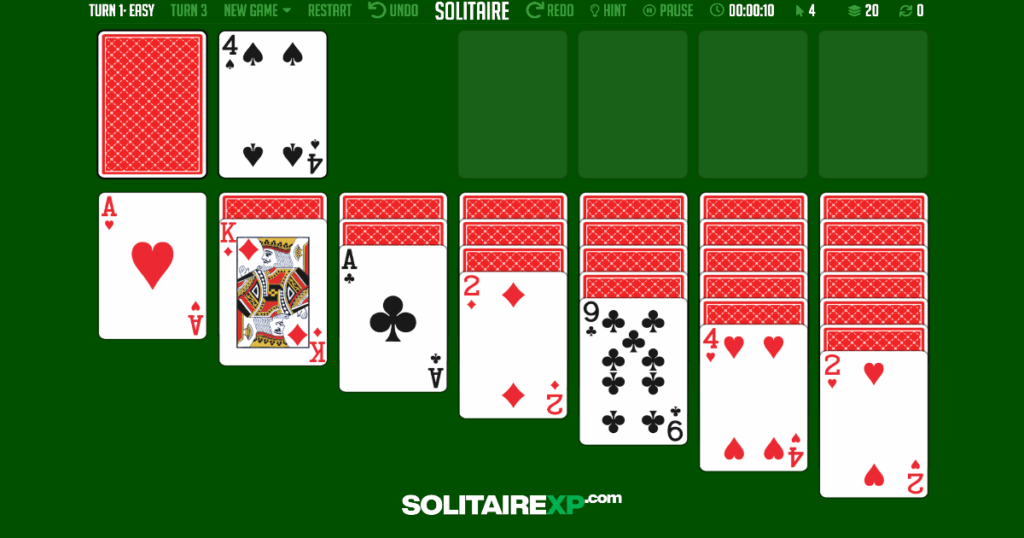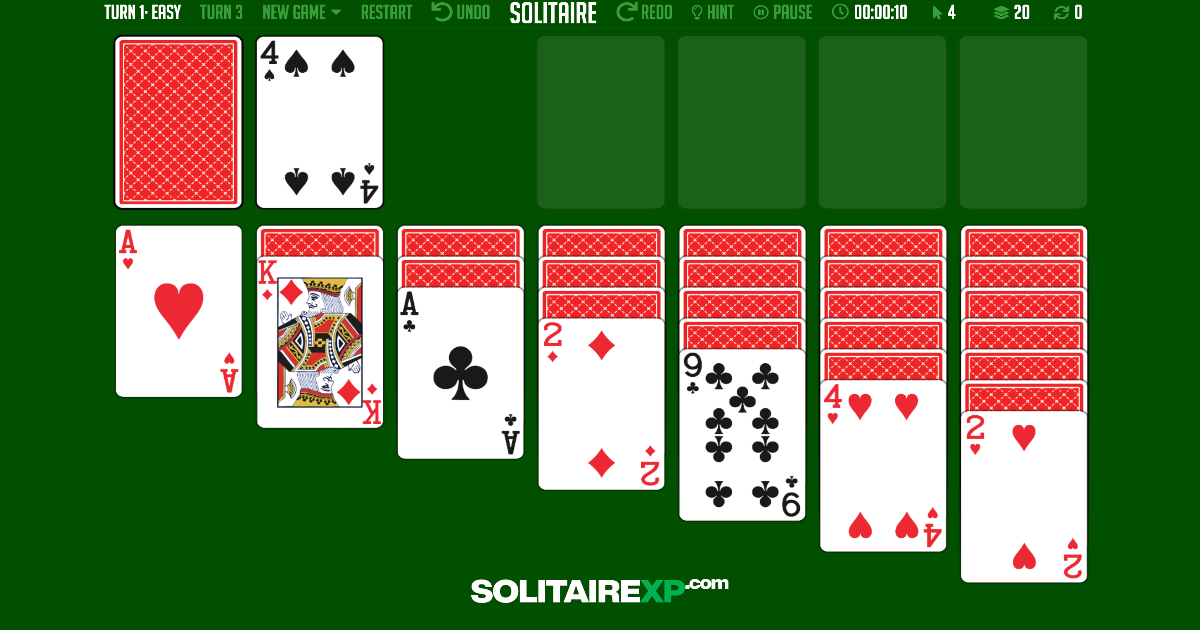Welcome to the ultimate guide to learning Solitaire! This timeless card game, also known as Klondike, is a perfect way to relax and challenge your mind. While it might look complex, the rules are simple and rewarding.
This guide will teach you everything you need to know, from the objective to winning strategies, with helpful pictures along the way.
In a Hurry? The 30-Second Guide
- The Goal: Move all 52 cards to the four Foundation piles (top right), from Ace to King by suit.
- The Main Move: Build columns on the main table (Tableau) downwards (K, Q, J…) with alternating colors (red on black).
- How to Win: Once all cards are in the Foundations, you’ve won!
The Objective: What’s the Goal of Solitaire?
The main goal of Klondike Solitaire is to move all 52 cards from the playing area onto the four Foundation piles.
Each Foundation pile must be built for a single suit (Hearts ♥, Diamonds ♦, Spades ♠, Clubs ♣) and must be arranged in ascending order, starting with the Ace and ending with the King (A, 2, 3… J, Q, K).
Understanding the Board: The 4 Key Zones

1. The Tableau
This is the main playing area, consisting of seven columns of cards. The first column has one card, the second has two, and so on. Only the top card of each column is face-up.
2. The Stockpile (or Deck)
The pile of remaining face-down cards at the top left. You’ll draw from this pile when you’re out of moves.
3. The Waste Pile
When you draw from the Stockpile, cards are moved face-up to the Waste Pile. The top card of the Waste is available for play.
4. The Foundations
The four empty piles at the top right. This is where you build your suits from Ace to King to win the game.
The Core Rules: How to Move the Cards
These are the essential rules you’ll use in every game.
Rule 1: Building on the Tableau
This is your primary move. You can move a face-up card onto another if it follows two conditions:
- Descending Order: The card must be one rank lower (e.g., a 9 on a 10).
- Alternating Colors: The card must be the opposite color (e.g., a red 9 ♥ on a black 10 ♠).
You can also move an entire sequence of correctly ordered cards (e.g., red 9, black 8, red 7) as a single unit.
Rule 2: Using the Stockpile
When you have no more moves on the Tableau, click the Stockpile. In “Turn 1” mode, one card is drawn. In “Turn 3” mode, three cards are drawn, but only the top one is playable.
Rule 3: Moving Cards to the Foundations
If you have an Ace, you can move it to an empty Foundation pile. After that, you can add the next card of the same suit in order (e.g., the 2 of Spades on the Ace of Spades).
Rule 4: Using Empty Tableau Columns
An empty column can only be filled by a King. This is a powerful move to unlock other cards.
A Step-by-Step Walkthrough (Your First Moves)
Let’s put the rules together. Imagine this is your starting board:
- Scan for Immediate Plays: Look at the face-up cards. Do you see a card you can move? For example, if you see a red 6 and a black 7, you can immediately move the red 6 onto the black 7.
- Reveal a New Card: After moving the red 6, the card underneath it is now face-down. Click it to flip it over. This reveals a new card and gives you more options.
- Check for Aces: Do you see any Aces? If so, move them to the Foundations to get started.
- Draw from the Stockpile: If you have no more moves on the Tableau, click the Stockpile to see a new card.
Practice Makes Perfect: Try a Game Now!
The best way to learn is by playing. Try a game of Klondike Turn 1 right here!
3 Essential Strategies for Beginners
Knowing the rules is one thing, but winning requires strategy.
- Prioritize Revealing Cards: Your first goal should always be to make moves that flip over face-down cards in the Tableau. More cards mean more options.
- Don’t Rush the Foundations: It’s tempting to move cards to the Foundations immediately, but sometimes you need those low-ranking cards in the Tableau to move other cards around.
- Focus on Emptying Columns: Creating an empty column is a powerful strategic advantage, as it allows you to place a King there and start rearranging long sequences.
Frequently Asked Questions (FAQ)
What’s the difference between Turn 1 and Turn 3?
Turn 1 draws one card from the Stockpile at a time and is better for beginners. Turn 3 draws three cards, making the game more challenging as you can only play the top card.
Are all Solitaire games winnable?
No, not every game of Klondike Solitaire is winnable due to the luck of the draw. However, strategic play dramatically increases your chances. Variants like FreeCell are almost always winnable.
Can I move a card from the Foundation back to the Tableau?
Yes! This is a key strategic move. If you need a card from the Foundation to help you unlock other cards in the Tableau, you can move it back down.
You are now fully equipped to play and win at Solitaire. Good luck!

Comments (0)